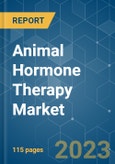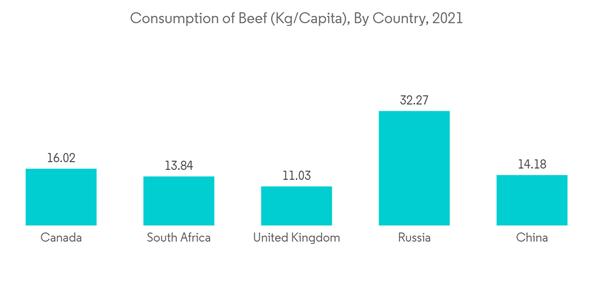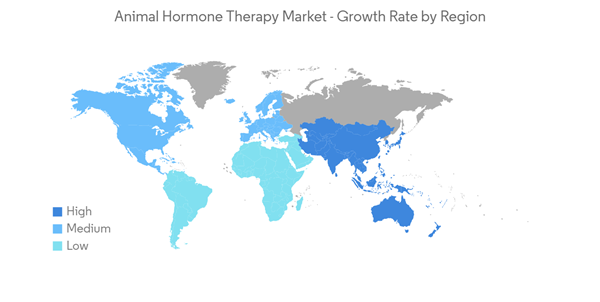The animal hormone therapy market is expected to register a CAGR of 5.52% over the forecast period.
With the outbreak of COVID-19, the animal hormone therapy industry has faced both patterns. Initially, when the pandemic struck, with a rise in a sudden demand for meat, eggs, milk, and other animal food products, the industry faced a sudden spike in demand for growth promoters and performance enhancers. Since animal food processing is not such a process where human involvement and proximity are avoided with animals and humans, the units have to shut down amid the threat of spreading COVID-19. Thus, the market faced a demand reduction. However, the animal hormone used for therapeutic purposes for animals remained continuously in demand and supported the industry. Thus, COVID-19 is expected to show a considerable positive impact on the animal hormone therapy market.
The market growth is predominantly characterized by factors such as the growing burden of hormonal deficiency diseases in animals, rising demand for meat, and increasing animal husbandry. The growing burden of diseases in animals drives the market by focusing on hormones used in the treatment of hormonal deficiency diseases, neoplasia treatment, or replacement therapy. According to the BMC study journal published in November 2021, reproductive system tumors occupied the highest share (39.84%), followed by cutaneous tumors (28.05%), digestive tumors (18.70%), and ocular tumors (4.47%). Among the reproductive system tumors, breast tumors are the most common in female pet dogs, especially for Pekingese (11.43%). Similarly, according to the Pathogenesis of Endocrine Disease in Animals Article of April 2020, hyperthyroidism, Type I diabetes, primary hyperparathyroidism, and primary hyperadrenocorticism were the most common diseases in small animals that involved endocrine hypofunction. Animal hormones are used for fattening and production-boosting purposes in the animal food industry.
In June 2021, the US Department of Agriculture reported a decline in beef production over a year but a strong demand for broilers, turkey, and pork. Moreover, the rate of animal husbandry is increasing all over the world, which largely concerns animal hormone use for the better health of animals. According to the Report of National Agricultural Statistics Services, United States, in April 2021, broiler production in the United States has been increasing over the last five decades. Thus, concerning the above facts, the animal hormone market is expected to witness significant growth over the forecast period owing to the increase in animal breeding and the rise in animal care.
Although animal hormone therapy has wide applications, the risks associated with the use of animal hormones and the stringent regulatory norms associated with their use may hamper the growth of the animal hormone therapy market.
Livestock animals include cattle, swine, poultry, aquaculture species, etc. The response of hormones varies largely among animals. When the same concentration of estradiol is used in pigs and cattle to increase meat products, a significantly less increase in lean meat is seen compared to cattle. According to the OECD report published in 2021, globally, poultry meat is expected to represent 41% of all the protein from meat sources in 2030, an increase of 2% compared to the base period. Furthermore, in the United States, any feed ingredients and medicines administered to animals are regulated by the US FDA. According to the National Agricultural Statistics Service (NASS) report, the total number of cattle herds in the United States was 93.6 million in January 2021. In order to meet the rising demand for meat consumption, the demand for hormonal therapy is expected to grow in the future.
The IOP article published in September 2020 mentioned that progesterone and GnRH therapy also play a role in the reactivation of ovaries in cows in delayed and hostile cases. The report also mentioned that the response to treatment with nutritional improvement was significantly more than 1%. Thus, the uses of hormone therapy in livestock animals are expected to drive the demand for hormone therapy, thereby contributing to the growth of the segment over the forecast period.
According to the February 2020 Report of the FCC Economics, the domestic demand for red meat in Canada remained robust in 2020; there was a significant rise in the price of beef by 3.5% and 0.7% in pork. A rise in demand for meat in the market accounts for more business, driving the demand for hormone therapy to increase the nutritional content in meat-producing animals, thereby contributing to the market's growth.
In June 2021, Poultry World Article reported that net egg production in Canada rose by 2.1% in 2020, accounting for a rise of about 3.9%. The increasing demand for nutritious and healthy animal-derived products directly boosts the demand for performance enhancers and health and growth-promoting feed and supplies. In June 2021, the US Department of Agriculture (USDA) announced an investment of about USD 55.2 million in mid-and small-sized poultry processors and producers to build capacity and increase economic opportunity for them across the country.
In April 2022, Bovine somatotrophin, an animal growth hormone, was approved by the FDA to increase milk production in dairy cows. Government authorities are taking steps to encourage the participation of different players and various hormone therapies across the world to make the North American market a preferable choice.
Thus, the above-mentioned factors are expected to drive the growth of the market during the forecast period.
This product will be delivered within 2 business days.
With the outbreak of COVID-19, the animal hormone therapy industry has faced both patterns. Initially, when the pandemic struck, with a rise in a sudden demand for meat, eggs, milk, and other animal food products, the industry faced a sudden spike in demand for growth promoters and performance enhancers. Since animal food processing is not such a process where human involvement and proximity are avoided with animals and humans, the units have to shut down amid the threat of spreading COVID-19. Thus, the market faced a demand reduction. However, the animal hormone used for therapeutic purposes for animals remained continuously in demand and supported the industry. Thus, COVID-19 is expected to show a considerable positive impact on the animal hormone therapy market.
The market growth is predominantly characterized by factors such as the growing burden of hormonal deficiency diseases in animals, rising demand for meat, and increasing animal husbandry. The growing burden of diseases in animals drives the market by focusing on hormones used in the treatment of hormonal deficiency diseases, neoplasia treatment, or replacement therapy. According to the BMC study journal published in November 2021, reproductive system tumors occupied the highest share (39.84%), followed by cutaneous tumors (28.05%), digestive tumors (18.70%), and ocular tumors (4.47%). Among the reproductive system tumors, breast tumors are the most common in female pet dogs, especially for Pekingese (11.43%). Similarly, according to the Pathogenesis of Endocrine Disease in Animals Article of April 2020, hyperthyroidism, Type I diabetes, primary hyperparathyroidism, and primary hyperadrenocorticism were the most common diseases in small animals that involved endocrine hypofunction. Animal hormones are used for fattening and production-boosting purposes in the animal food industry.
In June 2021, the US Department of Agriculture reported a decline in beef production over a year but a strong demand for broilers, turkey, and pork. Moreover, the rate of animal husbandry is increasing all over the world, which largely concerns animal hormone use for the better health of animals. According to the Report of National Agricultural Statistics Services, United States, in April 2021, broiler production in the United States has been increasing over the last five decades. Thus, concerning the above facts, the animal hormone market is expected to witness significant growth over the forecast period owing to the increase in animal breeding and the rise in animal care.
Although animal hormone therapy has wide applications, the risks associated with the use of animal hormones and the stringent regulatory norms associated with their use may hamper the growth of the animal hormone therapy market.
Animal Hormone Therapy Market Trends
Livestock Animal Segment is Expected to Witness Growth Over the Forecast Period
Hormones can be used as a supplement or to replace any particular deficient hormone in animals. Steroidal hormones such as androgens, estradiol, progesterone, and testosterone are anabolic hormones used for promoting growth, production, and breeding in animals. The steroidal hormones are either implanted in the ear or injected intramuscularly into the animals.Livestock animals include cattle, swine, poultry, aquaculture species, etc. The response of hormones varies largely among animals. When the same concentration of estradiol is used in pigs and cattle to increase meat products, a significantly less increase in lean meat is seen compared to cattle. According to the OECD report published in 2021, globally, poultry meat is expected to represent 41% of all the protein from meat sources in 2030, an increase of 2% compared to the base period. Furthermore, in the United States, any feed ingredients and medicines administered to animals are regulated by the US FDA. According to the National Agricultural Statistics Service (NASS) report, the total number of cattle herds in the United States was 93.6 million in January 2021. In order to meet the rising demand for meat consumption, the demand for hormonal therapy is expected to grow in the future.
The IOP article published in September 2020 mentioned that progesterone and GnRH therapy also play a role in the reactivation of ovaries in cows in delayed and hostile cases. The report also mentioned that the response to treatment with nutritional improvement was significantly more than 1%. Thus, the uses of hormone therapy in livestock animals are expected to drive the demand for hormone therapy, thereby contributing to the growth of the segment over the forecast period.
North America is Expected to Hold a Significant Share in the Market Over the Forecast Period
North America, along with Canada, the United States, and Mexico, has one of the best infrastructures in terms of animal healthcare facilities. With the focus on continuous research on animals and technologically advanced processes for animal product processing, North America is expected to dominate the market over the forecast period.According to the February 2020 Report of the FCC Economics, the domestic demand for red meat in Canada remained robust in 2020; there was a significant rise in the price of beef by 3.5% and 0.7% in pork. A rise in demand for meat in the market accounts for more business, driving the demand for hormone therapy to increase the nutritional content in meat-producing animals, thereby contributing to the market's growth.
In June 2021, Poultry World Article reported that net egg production in Canada rose by 2.1% in 2020, accounting for a rise of about 3.9%. The increasing demand for nutritious and healthy animal-derived products directly boosts the demand for performance enhancers and health and growth-promoting feed and supplies. In June 2021, the US Department of Agriculture (USDA) announced an investment of about USD 55.2 million in mid-and small-sized poultry processors and producers to build capacity and increase economic opportunity for them across the country.
In April 2022, Bovine somatotrophin, an animal growth hormone, was approved by the FDA to increase milk production in dairy cows. Government authorities are taking steps to encourage the participation of different players and various hormone therapies across the world to make the North American market a preferable choice.
Thus, the above-mentioned factors are expected to drive the growth of the market during the forecast period.
Animal Hormone Therapy Market Competitor Analysis
The animal hormone therapy market is highly competitive, with several players across the world. In terms of market share, major players currently dominate the market. With the increasing burden of diseases and technological advancement in animal healthcare, many new players are expected to be part of the market over the forecast period. Some of the major players are Merck & Co. Inc., Boehringer Ingelheim, Elanco Inc., Virbac Group, and Vetoquinol SA.Additional benefits of purchasing the report:
- The market estimate (ME) sheet in Excel format
- 3 months of analyst support
This product will be delivered within 2 business days.
Table of Contents
1 INTRODUCTION
4 MARKET DYNAMICS
5 MARKET SEGMENTATION (Market Size by Value - USD million)
6 COMPETITIVE LANDSCAPE
Companies Mentioned (Partial List)
A selection of companies mentioned in this report includes, but is not limited to:
- Merck & Co. Inc.
- Zoetis Inc.
- Elanco (Bayer Animal Health)
- Boehringer Ingelheim
- Bimeda Animal Health
- Soparfin SCA (Vetiquinol)
- Virbac Group
- CEVA Sante Animale
- HIPRA Animal Health
- Syntex SA
- Huvepharma
- Jurox Pty Ltd
Methodology

LOADING...










